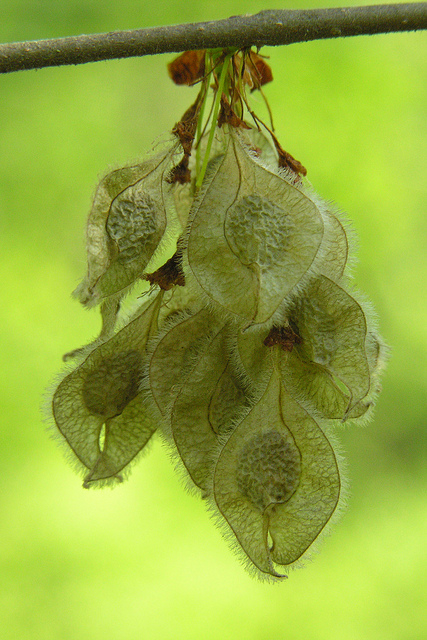American Elm
Ulmus americana L.
Description
American elm or white elm (family Ulmaceae) is a deciduous tree that can reach heights of 125 ft and diameters of 60 inches in the best habitats.1 It lives 175 to 200 years and even to 300 years.7 Its vase-shaped, broad crown makes it a favorite tree for urban environments.2 The bark is gray and deeply furrowed. The leaves are dark green, up to six inches long with a doubly serrated (two sizes of teeth) margin, and an asymmetrical base.2 Leaves are smooth on the upper surface.2 The inconspicuous flowers are bisexual and wind pollinated. They produce a single seeded fruit with a surrounding membranous wing about 0.5 in long with ciliated margins.2

Trunk and bark of American elm, B. Hubrick, Maryland Plant Atlas ³

American elm fruits, R. Klips, Maryland Plant Atlas. 3

Leaf of American elm. K. Johnson, Maryland Plant Atlas³
Distribution
Found most frequently in bottom lands, American elm grows from Nova Scotia west to Manitoba, south to Texas and Florida and along the Atlantic Seaboard. It occurs throughout Maryland, but is most abundant (at least historically) in central Maryland.³ It prefers moist, flat, well-drained soils, but can be found in many habitats not subjected to prolonged flooding.1 Its tolerance of pollution makes it a desirable street tree, but its current distribution is curtailed by susceptibility to Dutch elm disease.
%20-%20USGS%20Distribution%20Map.jpg)
Natural distribution of American elm, USGS6
Wildlife importance
American elm is a host for numerous butterfly and moth larva including Morning Cloak, painted Lady and Question Mark.4 Seeds are consumed by songbirds and small mammals.4
Economic importance
The wood is primarily used for furniture and lumber. Because of its ability to bend it is particularly desirable for hockey sticks.¹ Because of its rapid growth rate, tolerance to urban pollution, shape, and deep shade, American elm is a desirable sweet tree. ¹
Threats
American elm is highly susceptible to Dutch elm disease caused by a fungus (Ophiostoma ulmi) carried by a beetle.7 Infestation plugs the water conducting cells (xylem), kills branches, and ultimately kills the entire tree.7 The fungus has eliminated American elms throughout their range.1,5 Backcrossing with resistant elms and genetic engineering has produced resistant cultivars.¹ The “Princeton” and “Jefferson” are two disease resistant varieties that are widely used as replacements. Numerous other fungi and insects attack the tree, but most are not as lethal as Dutch elm disease.
Interesting facts
- American elm was the favorite street tree throughout much of the United States and lined the walkways of many university campuses. These are all virtually absent today.
- American elm has twice the number of chromosomes as that of all other elms (56 vs. 28), which makes difficult the breeding hybrids for fungal resistance. ¹
- Despite its name, the origin of Dutch elm disease is likely to be Asia. It was first described by a Dutch scientist.5 The disease arrived in North America in the early 1930s on a shipment of elm logs from Europe.¹
- The champion American Elm is in Baltimore County, Maryland with a height of 112 feet and a diameter of 82.8 inches. 8
References
- USDA-Forest Service Silvics, Volume 2: Ulmus americana
- Missouri Botanical Garden: Ulmus americana
- Maryland Plant Atlas, American Elm
- North Carolina State Extension: Ulmus americana
- The Morton Arboretum: Dutch elm disease
- USGS American Elm Distribution Map
- USDA, Fire Effects Information System: Ulmus americana
- American Forests: Ulmus americana
Contributed by J. Hull
